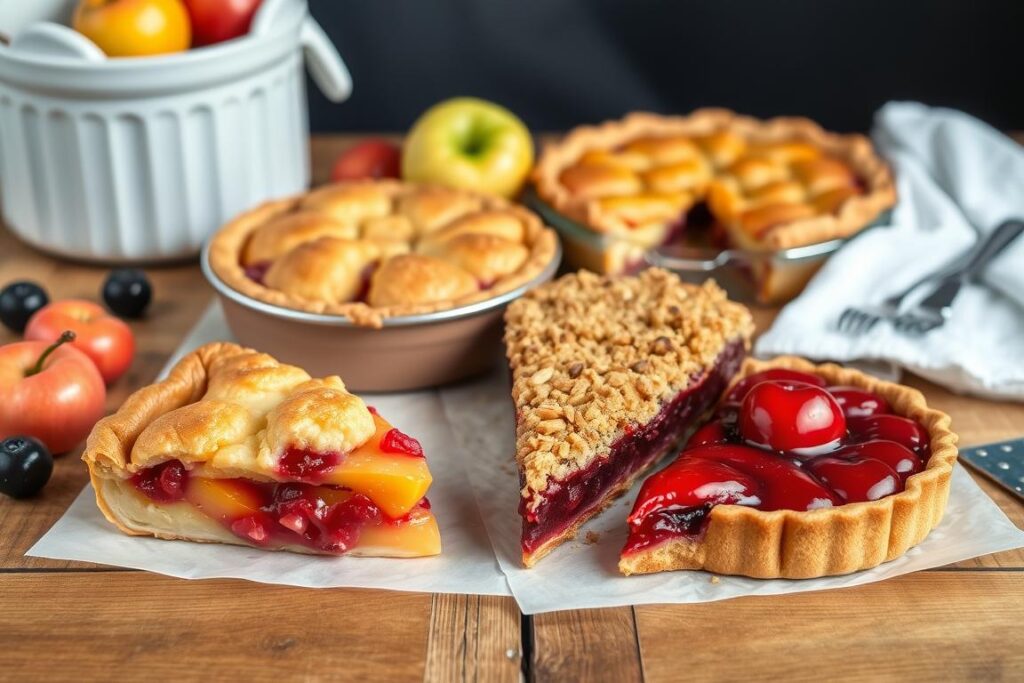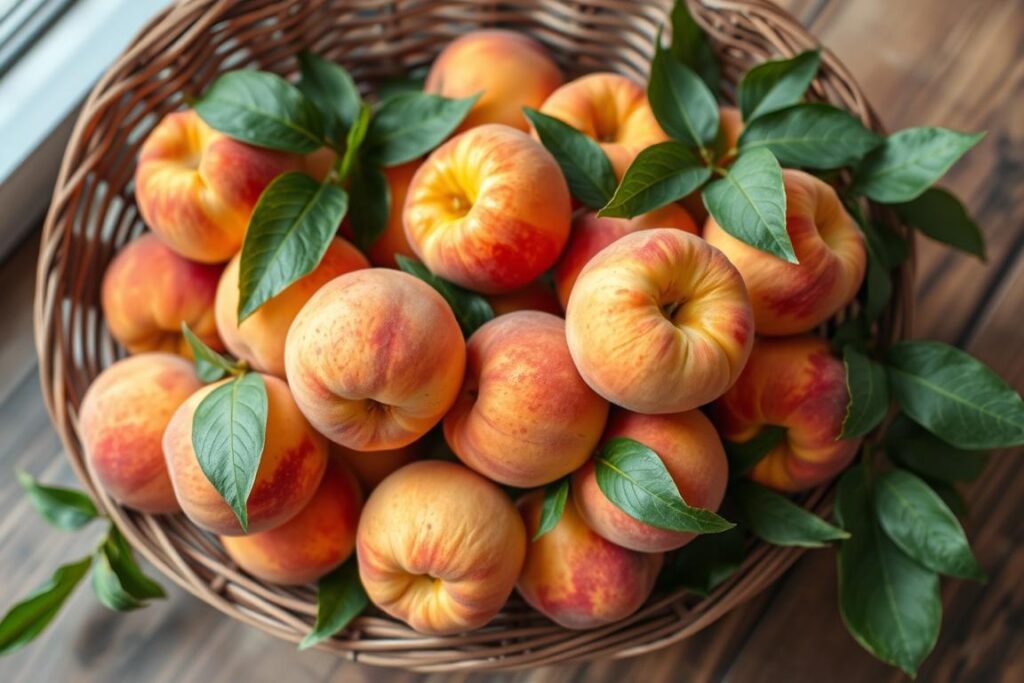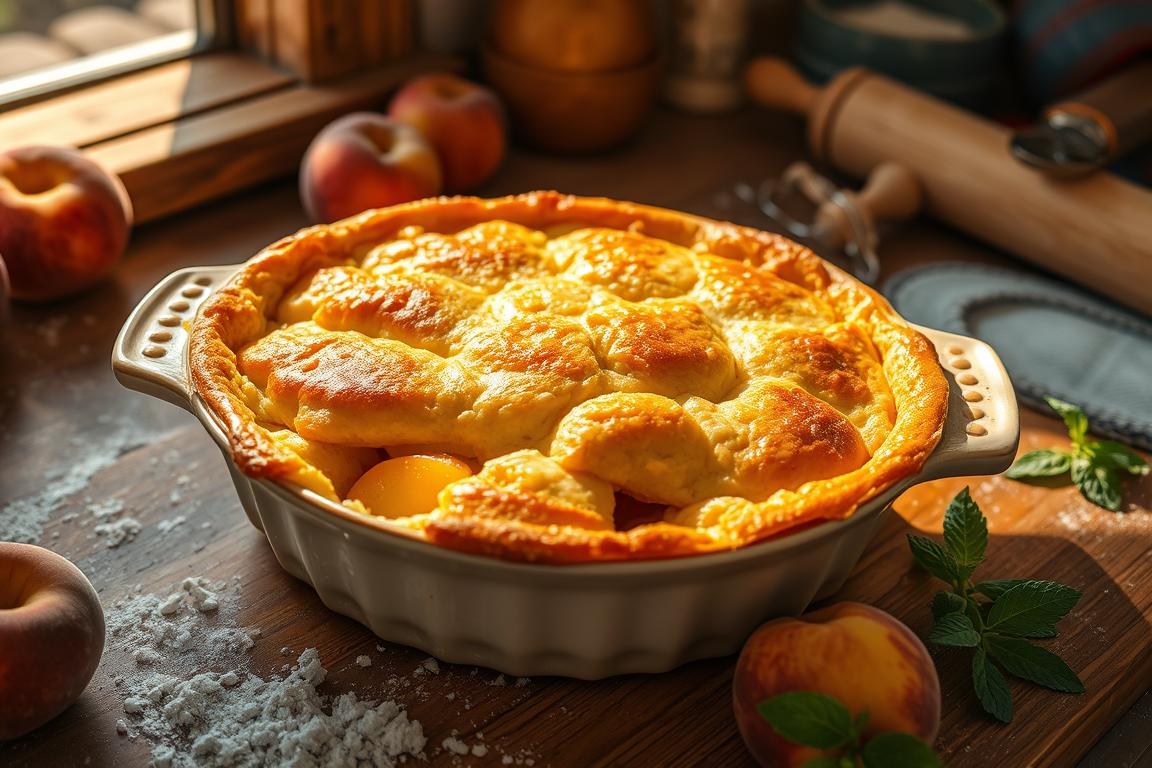Summer’s favorite dessert, the peach cobbler, has won many hearts. It has over 3,000 five-star ratings. This classic dessert is quick to make, ready in just one hour. Your journey to avoid a soggy cobbler begins here.
To make the perfect peach cobbler, picking ripe peaches is key. Look for a golden color near the stem and a slight softness. They should also smell sweet and inviting. You can use fresh, canned, or frozen peaches, but keep the texture right.
A peach cobbler recipe calls for about 5 cups of sliced peaches. That’s 750-900 grams of fresh yellow peaches. If fresh peaches are hard to find, 32 ounces of frozen ones are a great substitute. Your goal is to have juicy fruit and a crispy, golden topping.
Managing moisture is the trick to avoiding a soggy cobbler. Using cornstarch, choosing the right baking dish, and balancing fruit and topping are key. These steps can turn your dessert into a masterpiece.
Understanding the Perfect Peach Cobbler Texture
Exploring fruit desserts shows us what makes each one unique. Your journey starts with learning about cobbler texture. It’s about knowing the differences between similar desserts.
Distinguishing Fruit Dessert Types
Not all fruit desserts are the same. Let’s look at the main differences:
- Cobbler: Has a biscuit-like topping over fruit
- Crisp: Topped with a crunchy mix of oats, flour, and butter
- Crumble: Like crisp but with a softer, more crumbly topping

Peach Dessert Consistency Explained
The perfect peach cobbler has a gooey filling and a great topping. For the best texture, use peach chunks that are at least half an inch thick. This keeps them firm while baking and releases just the right juice.
Crafting the Perfect Cobbler Topping
A good cobbler topping is like a mix between a cake and a biscuit. It should be slightly underbaked with a crispy, sugary top. The goal is a soft base and a golden-brown, crunchy top that’s a delight to eat.
| Topping Characteristic | Ideal Texture |
|---|---|
| Moisture Level | Slightly moist, not dry |
| Surface Texture | Crispy and golden-brown |
| Interior | Soft and tender |
By mastering these details of cobbler texture, you’ll improve your fruit dessert skills. You’ll make a peach cobbler that’s unforgettable and stands out from others.
Selecting and Preparing Peaches for Your Cobbler

Choosing the right peaches is key for a tasty peach cobbler. Look for fruits with a golden hue near the stem and a slight softness. The best peaches have a sweet, fragrant smell that promises great flavor.
Fresh peaches are the best choice for cobbler. But, if fresh ones are hard to find, here’s a guide to help:
- Fresh Peaches:
- Select peaches with vibrant color
- Check for slight give when pressed
- Smell for a sweet, fruity fragrance
- Fresh vs Frozen Peaches:
- Fresh peaches offer optimal flavor
- Frozen peaches work well when fresh are unavailable
- Use about 40 ounces of frozen peaches for a standard recipe
Peeling is optional but recommended. Pro tip: To easily remove peach skin, blanch peaches in boiling water for 30 seconds, then immediately transfer to an ice bath. The skin will slip off effortlessly. When slicing, aim for uniform ½ to ¾ inch thick pieces to ensure even cooking and a perfectly jammy filling.
Avoid using canned peaches, as they can make your cobbler filling gummy and less flavorful. If your peaches are slightly unripe, let them sit at room temperature for a few days to develop sweetness and soften.
How to Keep Peach Cobbler from Getting Soggy?
Making the perfect peach cobbler needs some smart moves to avoid a soggy mess. It’s all about managing moisture and getting the right texture. You want a crispy top and a juicy fruit filling.
Cornstarch: Your Secret Weapon to Thicken Peach Filling
Cornstarch is your best friend to keep the cobbler from getting soggy. Just add 1-2 tablespoons of cornstarch to soak up extra liquid from the peaches. This trick makes the cobbler both juicy and firm.
- Sprinkle cornstarch directly into peach mixture
- Mix thoroughly to distribute evenly
- Allow filling to sit for 10-15 minutes before baking
Mastering the Fruit to Topping Ratio
Finding the perfect balance between fruit and topping is key to a non-soggy cobbler. Use a shallow baking dish about 9×13 inches. This size helps with even heat and keeps moisture in check.
| Baking Dish Recommendation | Impact on Cobbler |
|---|---|
| Shallow 9×13 inch dish | Even heat, reduced moisture |
| Deep dish | Potential for soggy bottom |
Baking Techniques for a Crisp Cobbler
Bake your peach cobbler at 375°F to set the crust right. A pro tip is to leave space between the topping dollops. This lets excess liquid evaporate, making the cobbler crispy and delicious.
- Preheat oven to 375°F
- Spread topping with small gaps
- Bake until golden and set
- Cool for 15 minutes before serving
Essential Tips for the Perfect Cobbler Topping
Making a crispy cobbler topping needs precision and skill. You want a biscuit-like crust that turns a simple dessert into a special treat. The key is finding the right mix of texture and flavor.
To make a sugar-crusted cobbler that wows your guests, keep these tips in mind:
- Drop spoonfuls of batter loosely over the fruit, leaving spaces for steam to escape
- Sprinkle turbinado sugar generously before baking for extra crunch
- Use cold butter cut into small pieces for maximum flakiness
- Avoid overmixing the topping to prevent a tough texture
The perfect cobbler topping is like a mix between a cake and a biscuit. Imagine it as slightly underbaked cookie dough with a golden, crispy outside. Bakers say using all-purpose flour and a bit of baking powder helps it rise just right.
To get that golden finish, broil your cobbler for 2-3 minutes at the end. This step adds a caramelized, sugar-crusted top that looks and tastes amazing. Just be careful not to burn it!
Remember, spacing is key. Too much topping can trap moisture and make the crust soggy. By following these tips, you’ll get a peach cobbler with a topping that’s crisp, delightful, and loved by all.
Storage and Serving Recommendations
After baking a tasty peach cobbler, knowing how to store and serve it is key. The right methods keep your cobbler delicious for days. It’s all about the storage and reheating.
Proper Cooling Techniques
Letting your peach cobbler cool is important for the perfect texture. Let it rest for 20-30 minutes after baking. This time helps the filling set and makes it rich and saucy.
Best Storage Practices
Here’s how to store peach cobbler:
- Cover it with plastic wrap or aluminum foil
- Refrigerate for up to 4-5 days
- Keep it at a temperature below 40°F
Reheating Methods
Here are ways to reheat your cobbler:
- Oven Method: Bake at 350°F for 15-20 minutes
- Microwave Method: Heat individual portions for 30-45 seconds
For an extra special treat, top your peach dessert with vanilla ice cream or whipped cream.
| Storage Method | Duration | Temperature |
|---|---|---|
| Refrigerated | 4-5 days | Below 40°F |
| Room Temperature | 1-2 days | 68-72°F |
Remember, a perfectly stored and reheated peach cobbler can taste just as delicious as when it first came out of the oven!
Conclusion
Creating the perfect peach cobbler needs focus and a few important steps. By following fruit cobbler tips, your summer dessert can go from good to great. Choosing ripe peaches and the right thickening agents are key to impressing everyone.
The secret to a great peach cobbler is in the balance. Use a 2:1 fruit-to-topping ratio for the perfect consistency. Letting it cool for 20-30 minutes after baking helps the filling set and enhances flavors.
These tips can help both new and experienced bakers make a better cobbler. By baking at 350°F and picking the right ingredients, you’ll make a dessert that showcases fresh peaches. Your peach cobbler will be a favorite, bringing happiness with every bite.
With time and effort, you’ll make peach cobblers as good as the pros. Enjoy the art of baking, try new things, and see the joy in your creations.
FAQ
What’s the difference between a cobbler, crisp, and crumble?
A cobbler has a deep-dish fruit dessert with a biscuit-like dough topping. This sets it apart from crisps and crumbles, which have a streusel or oat-based topping. Cobblers have a more cake-like or biscuit-style covering that’s dropped in spoonfuls over the fruit filling.
Can I use frozen or canned peaches for my cobbler?
Fresh peaches are best, but frozen peaches (about 40 ounces for a standard recipe) work too. Avoid canned peaches as they can make the filling gummy and lack fresh flavor and texture.
How do I prevent my peach cobbler from becoming soggy?
To avoid a soggy cobbler, use cornstarch or tapioca as a thickening agent (2 teaspoons to 1 tablespoon). Use a shallow baking dish and leave space between dollops of biscuit dough. This allows excess liquid to evaporate.
How do I know if my peaches are ripe enough for cobbler?
Choose peaches with a golden hue near the stem, a slight give when gently squeezed, and a sweet, fragrant smell. Unripe peaches can be ripened at room temperature. Peeling is optional, as the skin softens during baking.
How long can I store peach cobbler?
You can cover and refrigerate peach cobbler for up to 4 days. To reheat, microwave individual portions or bake the entire cobbler at 350°F (177°C) for about 20 minutes until warmed through.
What’s the best way to serve peach cobbler?
Peach cobbler is best served warm, with a 20-30 minute cooling period to achieve a thick, saucy consistency. It pairs perfectly with a scoop of vanilla ice cream or a dollop of whipped cream. You can enjoy it cold, at room temperature, or hot.
How do I get a crispy cobbler topping?
To achieve a crispy topping, drop spoonfuls of batter over the fruit, leaving spaces for steam to escape. Sprinkle turbinado sugar on top before baking, and finish with a few minutes under the broiler to create a golden-brown, crispy top.
Can I make peach cobbler ahead of time?
Yes, you can prepare the cobbler in advance and refrigerate it before baking. When ready to serve, bake it fresh, allowing extra time if it’s coming straight from the refrigerator. For best results, bake just before serving to maintain the crispy topping and warm, gooey filling.

